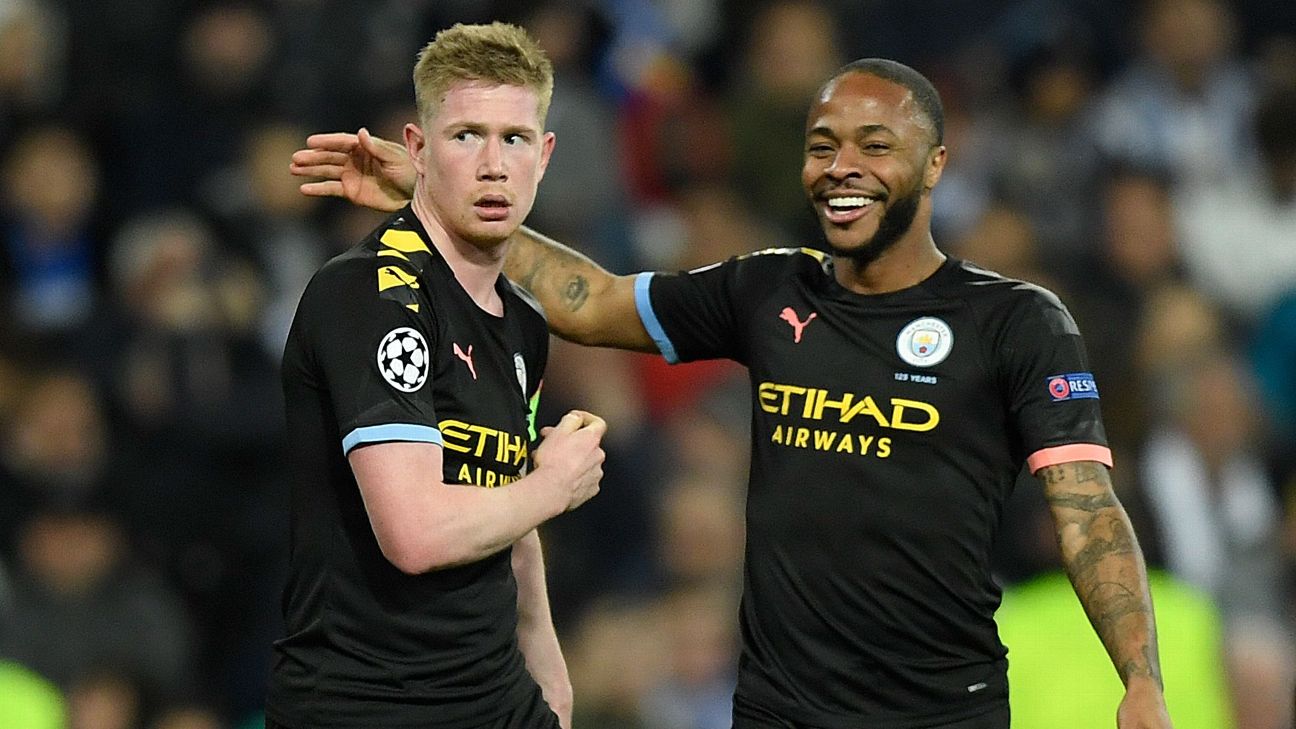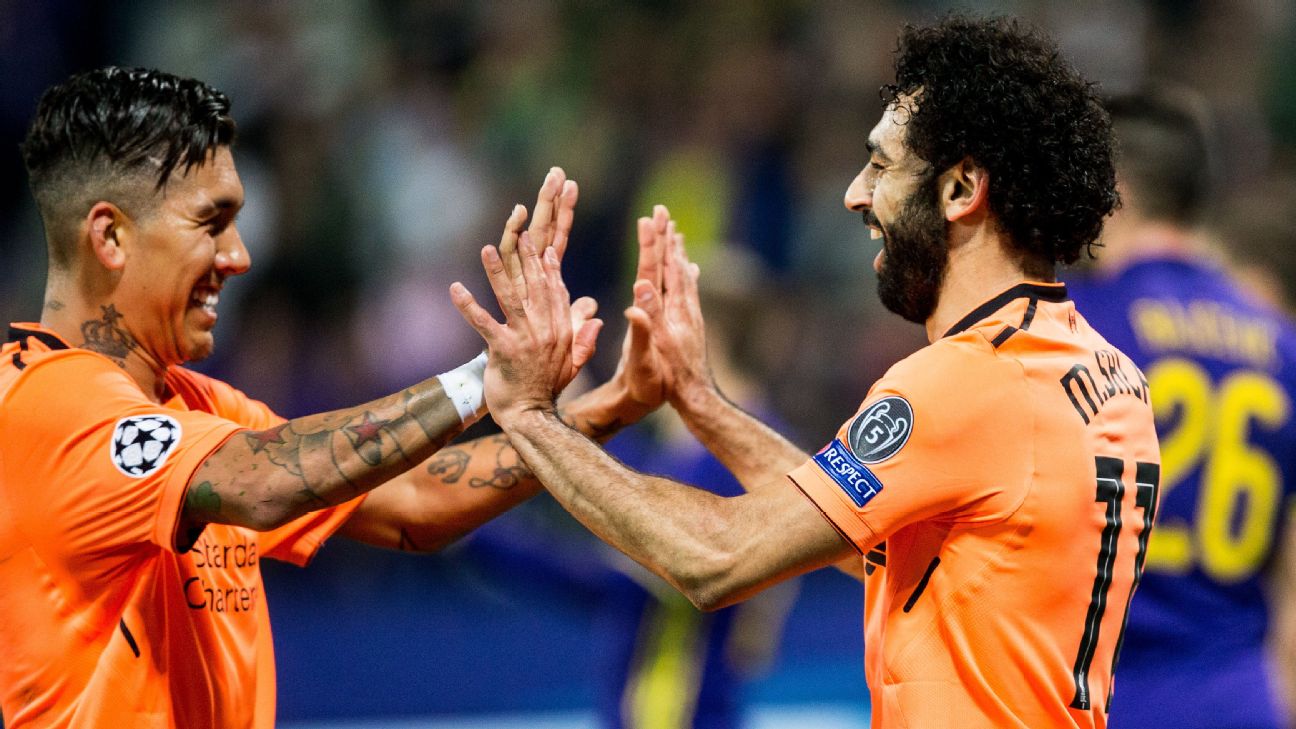Products You May Like
Duos are dying. Back when everyone played a 4-4-2, there were pairs everywhere. You had two centerbacks, wingers and full-backs, two midfielders and two strikers. The treble-winning Manchester United side of 1998-99 played Dwight Yorke and Andy Cole up front, and they combined for 52 goals across all competitions. A few years later, Arsenal went undefeated in the Premier League with Thierry Henry and Dennis Bergkamp playing together up top. There are some recent exceptions — see: Daniel Sturridge and Luis Suarez and their 52 combined league goals for Liverpool in 2013-14 — but most of the Premier League’s most prolific pairings played more than a decade ago. Stan Collymore and Robbie Fowler? Alan Shearer and Les Ferdinand? Anybody?
Today, your team doesn’t have world-class attack if that attack doesn’t also have a three-letter acronym that sounds like a media company: Karim Benzema, Gareth Bale and Cristiano Ronaldo were BBC, while Lionel Messi, Luis Suarez, and Neymar were MSN. Everything comes in threes now.
– Marcotti: Coronavirus’ impact on Serie A
– Connelly: Mourinho’s tactics so far at Tottenham
– Kuper: How Chelsea can get the best of Ziyech
No individual has shaped the modern game more than the late Johan Cruyff. The former Ajax and Barcelona star-player and star-manager once said, “Can’t play dominant football with 4-4-2. Triangles disappear. You should always have triangles; only then do you have passing options.” He’s right: three is better than two, after all.
Triangles provide more options and more levels to your play, too. Instead of a flat midfield four with two in front, there’s typically now a triangle in the middle — flip it any way you want — and a trio up top. Fullbacks might occupy the wings by themselves, or they’ll pinch into the midfield and form another triangle with one of the midfielders and one of the wingers, or they’ll hang back as a de facto third centerback. Even the still-present pairing between the two starting centerbacks is more than just that; a defensive midfielder might sit in front of them to make a triangle in defense, and then he might drop back between them in possession to provide three angles to pass the ball forward.
Of course, every triangle contains three separate pairs — pairs without a triangle, but no triangles without a pair. The way that we talk about soccer still isn’t totally connected to what we know about soccer, either. Thanks to the development of detailed on-ball data, we do know who’s good at scoring, shooting, passing and dribbling. (As I’ve written about in my newsletter, the answers are: Lionel Messi, Messi, Messi and Messi.) But there’s still very little widespread, objective information about how players interact with each other — how they gel, how their playing styles fit and how they can muffle or amplify each other’s best qualities.
To figure this out, a pair of researchers in Belgium and the Netherlands decided to look at just that: pairs. They’ve developed a system that determines how well two players perform together, both on the attacking and defensive end. And while Liverpool’s front three are the defining offensive force of the past few seasons, the researchers say that they have yet to find a duo as good as Mohamed Salah and Roberto Firmino.
At the MIT Sloan Sports Analytics Conference next week, Lotte Bransen and Jan Van Haaren from the analytics company SciSports will be presenting a paper called “Player Chemistry: Striving for a Perfectly Balanced Soccer Team.” (Full disclosure: The event is sponsored by ESPN.)
The conference was founded by Houston Rockets general manager Daryl Morey back in 2006, and it’s since become the premier annual event for people who work in or near analytics in sports. It’s not only for quants, though; it’s gone mainstream, as the conference now features plenty of current and former star athletes and top executives. In addition to all the talks you’d expect from any conference, there’s also a research-paper competition. Last year’s winner was a paper written about valuing actions across a soccer field. Its authors work for FC Barcelona, the Sacramento Kings and the Los Angeles Dodgers. This year, Bransen and Van Haaren’s paper is one of the nine finalists.
“Our chemistry metrics measure the joint impact that a pair of players has on their team’s performance,” they said. “That is, a pair is said to have high chemistry if their joint actions have a positive impact on their team’s performance. In terms of offensive chemistry, a pair’s performance is expressed with respect to their impact on scoring goals. In terms of defensive chemistry, a pair’s performance is expressed with respect to their impact on preventing goals.”
They first developed a model that, similar to last year’s winning paper at Sloan, puts a value on everything that happens with the ball based on how likely it is to lead to a goal. A two-yard sideways pass isn’t as valuable as playing a through-ball, for example. They then refined that process for the paper by looking at actions that players complete together. If a player makes a pass into the penalty area, the player who made the pass and the player who received the pass get statistical credit as a pairing. To determine the defensive impact, they look at how opposing attackers perform compared to past performance; if the attackers do worse, pairs of defenders are given credit based on their locations on the field.
Their two main top-level findings from the paper are both intuitive and not — the ideal mix for research like this because it tells you something new, but it also doesn’t claim that, say, Burnley are actually the best team in the world.
“We had expected that cultural aspects would play a bigger role in the chemistry between players than these aspects actually do,” they said. “In particular, we had expected players who have the same mother tongue to have higher chemistry than players who don’t have the same mother tongue, all else being equal, but a common mother tongue turns out to have little impact.” However, they also found that players do develop better chemistry over time, which makes sense given all the dynamic, on-the-fly thinking the game requires. It makes you wonder if the constant transfer-market roster churn isn’t a form of self-sabotage.
“In most cases, the chemistry between a pair of players starts increasing beyond the mark of 20 matches played together,” they said. “The number of matches is higher than what we had expected beforehand. In practice, players often don’t get that much time to get used to each other.”

Bransen and Van Haaren analyzed data going back to the 2015-16 season, and the most effective pairing they found was Firmino and Salah in the 2017-18 Champions League, followed by Messi and Luis Suarez during the 2015-16 La Liga campaign. In the Premier League this season, Liverpool’s Sadio Mane and Andy Robertson are the top-rated pair, followed by Kevin De Bruyne and Raheem Sterling (Man City), Youri Tielemans and Jamie Vardy (Leicester City), Salah and Firmino (Liverpool again), and then Wolves’ Adama Traore and Raul Jimenez.
Even just a cursory look at some of the results provides some actionable or explanatory info. Martin Odegaard is part of multiple top-5 duos in Spain this season: a scary thought given that he’s not owned by Real Sociedad. Sterling and Leroy Sane were tops in the Premier League last season, but they haven’t played a single Premier League minute together this season amid Man City’s (relatively) disappointing season. Paul Pogba and Anthony Martial were one of the highest-rated duos in England in each of the past two seasons, but they’ve both been in and out of the team as Manchester United’s attack has cratered.
Although they had limited time together, Liverpool’s Virgil van Dijk and Joe Gomez were among the Premier League’s top defensive duos last season, which perhaps foreshadowed their dominance this year. And despite his attack-first reputation, Kieran Trippier was part of the two highest-rated defensive duos in last year’s Champions League, with Son Heung-min and Christian Eriksen. Could Trippier, now at Atletico Madrid, have been more important to Tottenham than met the eye?
In addition to the pair ratings, the researchers also created a machine-learning model that looks at players with similar characteristics who have played together, and then uses that information to project how players on different teams would play together. In a sense, they’re trying to predict team chemistry. In the paper, they used the model to look at which team would be the best fit for Ajax’s Hakim Ziyech. Bayern Munich came up as the optimal landing spot, but Chelsea, whom Ziyech agreed to join after the paper was written but before it was published, were the second-best option, according to their model.
Liverpool fans, I promise I did not prompt them to give me this specific example.
“For example, our machine learning model predicts Adama Traoré to have low chemistry with Roberto Firmino and Mohamed Salah at Liverpool as Traoré’s playing style doesn’t fit Firmino’s and Salah’s playing styles very well,” they said. “In contrast, Heung-Min Son would be a much better fit with the current Liverpool players from a chemistry perspective.”
Bransen and Van Haaren see their model as a tool for both teams and players, both to better recruit (in the former’s case) and better decide on your next employers. They said that the battle now becomes trying to convince decision-makers within the sport that the information is actually worth looking at.
While soccer is a decade, if not decades, behind the other major sports in terms of analytical fluency, this is the rare bit of work that actually captures a truth about a sport: that individual players aren’t just stand-alone inputs and that they don’t just perform the same in every system, no matter who their teammates are. But that doesn’t mean there isn’t more work to be done, either. They eventually want to expand the rating system to groups of players larger than two.
Something tells me trios will be next.
